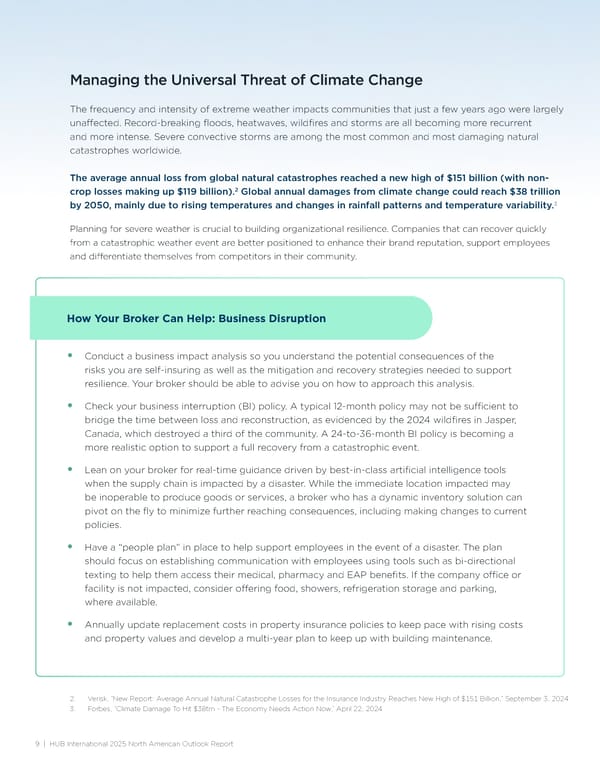Managing the Universal Threat of Climate Change The frequency and intensity of extreme weather impacts communities that just a few years ago were largely unaffected. Record-breaking floods, heatwaves, wildfires and storms are all becoming more recurrent and more intense. Severe convective storms are among the most common and most damaging natural catastrophes worldwide. The average annual loss from global natural catastrophes reached a new high of $151 billion (with non- 2 crop losses making up $119 billion). Global annual damages from climate change could reach $38 trillion 3 by 2050, mainly due to rising temperatures and changes in rainfall patterns and temperature variability. Planning for severe weather is crucial to building organizational resilience. Companies that can recover quickly from a catastrophic weather event are better positioned to enhance their brand reputation, support employees and differentiate themselves from competitors in their community. Here’s how your insurance broker can help you prepare for a major How Your Broker Can Help: Business Disruption business disruption: • Conduct a business impact analysis so you understand the potential consequences of the risks you are self-insuring as well as the mitigation and recovery strategies needed to support resilience. Your broker should be able to advise you on how to approach this analysis. • Check your business interruption (BI) policy. A typical 12-month policy may not be sufÏcient to bridge the time between loss and reconstruction, as evidenced by the 2024 wildfires in Jasper, Canada, which destroyed a third of the community. A 24-to-36-month BI policy is becoming a more realistic option to support a full recovery from a catastrophic event. • Lean on your broker for real-time guidance driven by best-in-class artificial intelligence tools when the supply chain is impacted by a disaster. While the immediate location impacted may be inoperable to produce goods or services, a broker who has a dynamic inventory solution can pivot on the fly to minimize further reaching consequences, including making changes to current policies. • Have a “people plan” in place to help support employees in the event of a disaster. The plan should focus on establishing communication with employees using tools such as bi-directional texting to help them access their medical, pharmacy and EAP benefits. If the company ofÏce or facility is not impacted, consider offering food, showers, refrigeration storage and parking, where available. • Annually update replacement costs in property insurance policies to keep pace with rising costs and property values and develop a multi-year plan to keep up with building maintenance. 2. Verisk, “New Report: Average Annual Natural Catastrophe Losses for the Insurance Industry Reaches New High of $151 Billion,” September 3, 2024 3. Forbes, “Climate Damage To Hit $38trn - The Economy Needs Action Now,” April 22, 2024 9 | HUB Int9 | HUB Internaernational 2025 North American Outlook Rtional 2025 North American Outlook Reporteport
 Outlook 2025: North American Report Page 8 Page 10
Outlook 2025: North American Report Page 8 Page 10